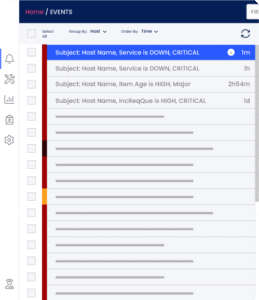NOC are always under a great deal of pressure to meet both technical and business service demands. In the past several years, NOC have played a more critical role in the growth and efficiency of a SaaS company. With this, technological issues arise at unexpected times. While the number of unforeseen problems increase, the resources within an organization always decrease.
Today, SaaS based companies are fundamentally operation based organizations, in comparison to the ‘classic’ development focused enterprise. The ramifications of this trend are evident when looking at the strong emphasis of NOC services. The NOC now requires more than an initial investment of resources, it demands that the operating of a NOC become a core business strategy within a company. The implication of such a change is that companies will need to invest more in human capital, process and data. Elevating the role of NOC engineers to strategic predictors will increase detection of potential issues BEFORE they arise. The NOC engineers are the ideal staff because they monitor the NOC 24/7 and are the most familiar with and sensitive to any potential problems. Additionally, their familiarity with the system will enable NOC engineers to respond and resolve to lower level issues, which will reduce pressure from R & D and IT departments, and allows them to focus on core business development. By elevating the NOC to a strategic business level, companies will ensure that the proper tools, skills and processes are being deployed to run an efficient operation.
The 3 main ingredients for a successful NOC are:
- Centralized Run-book management
- 24/7/365 Intelligent NOC
- Real-Time Monitoring platform
Run-book Operation and Centralized Dashboard
Successful NOC constitutes a service harmonization between the run-book process and a centralized dashboard. Targeting functionality optimization enables both the NOC team and the end user to benefit from a clear overview of the scale and extent of service productivity. In other words, by employing a Run-Book mechanism with a centralized dashboard a sound and smooth knowledge flow within the organization is established.
Centralized Dashboard provides each authorized person within the organization with a unified status view any time, at all times according to predefined and yet easily customizable key performance indicators and parameters.
Run-Book A process, which is incorporated into the operational workflow, which distills a crystal-clear and simple list of tasks and indices out of any architecture state, regardless its complexity. This Run-Book process forms an accurate transfer of a non-documented knowledge, accumulated by particular individuals, towards meticulous and constantly updating event documentation, which consequently reduces the dependency on single
24/7 Intelligent NOC Center
At its core, Uptime Management is dependent on 24/7 Network Operation Center (NOC). The NOC is not only responsible for controlling the network and bare metal infrastructure, the NOC actually manages the entire application and service operation. The NOC offers a broader, overarching analysis of the entire system operation. With this information, critical decisions can be approached in a proactive manner rather than a temporary, reactive response. In this manner, the NOC services promote a hands-on, continuous, business-focused monitoring approach.
A tiered IT support structure enables an organization to maximize its staff resources by allowing NOC engineers to address routine activities, freeing up higher‐level support engineers to focus on more advanced issues and implement strategic initiatives for the organization.
In a 24×7 proactive support environment, events or incidents, reported by servers, applications, or networks, can be detected, classified and recorded via the monitoring tools and consequently solved. For the sake of improving efficiency, customized monitoring dashboards are then used to filter out any irrelevant events or false positives.
Integrating a tiered support structure, utilizing a 24×7 NOC, enables an organization to detect, prioritize, escalate and efficiently resolve incidents without diverting resources of development engineers.
Real Time Monitoring
A crucial part of the Uptime Management service is real-time monitoring. This functionality is dependent on two critical factors
- The monitoring platform should be perfectly matched to the operational necessities of the specific business
- Monitoring is being conducted in a humanized manner to assure availability and attentiveness at all times, ensuring that all emerging situations receive the necessary attention in real-time.
There are 4 layers of Monitoring as part of Uptime Management:
- Bare Metal Monitoring
- Network Monitoring
- SLA Monitoring
- Application Monitoring
It goes without saying that all 4 layers of monitoring should be carried out in a precise and centralized manner. In other words, the Uptime Management provides a unified view of the entire IT operation aspects, which renders confidence and stability as enables the respective decision-makers to allocate skillful resources to other tasks and assignments within the organization.
Indeed, professional monitoring means continuous service leverage, as changes and updates to and from the cloud are constantly being implemented e.g. new modules. Real-time monitoring of both the application and its infrastructure secures the service smoothness, primarily based upon the critical assessments, stemming from the humanized NOC operation.


